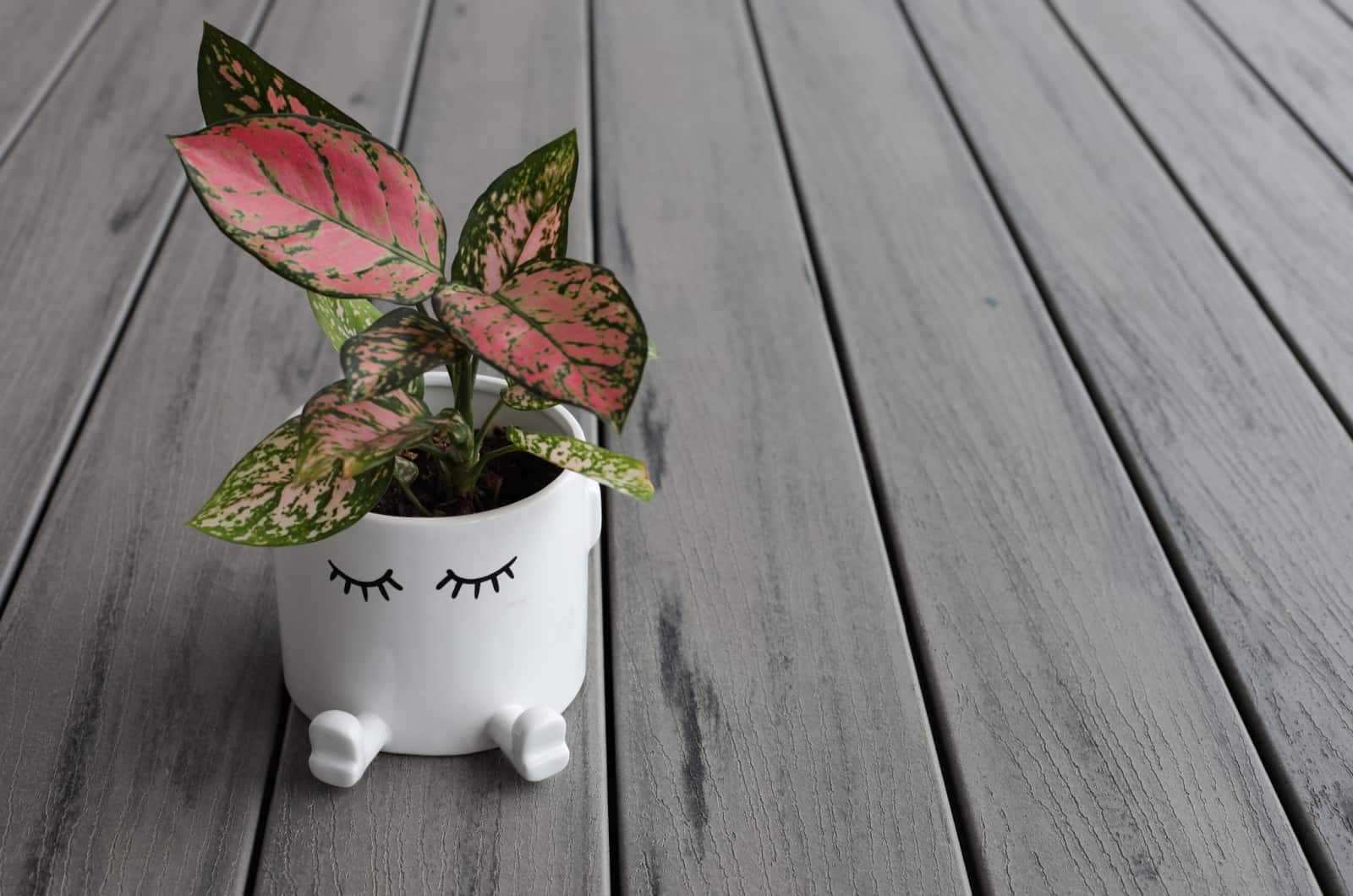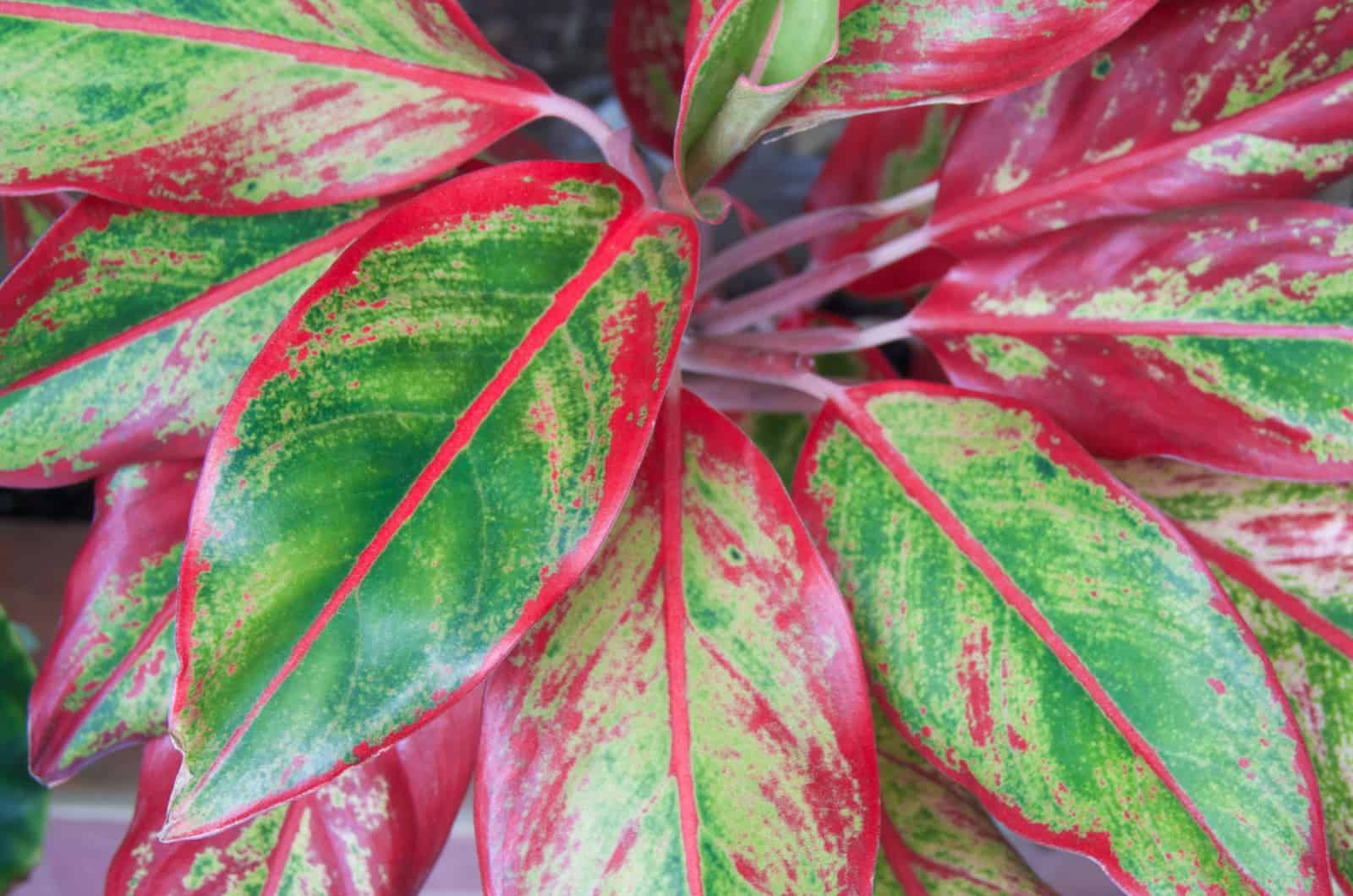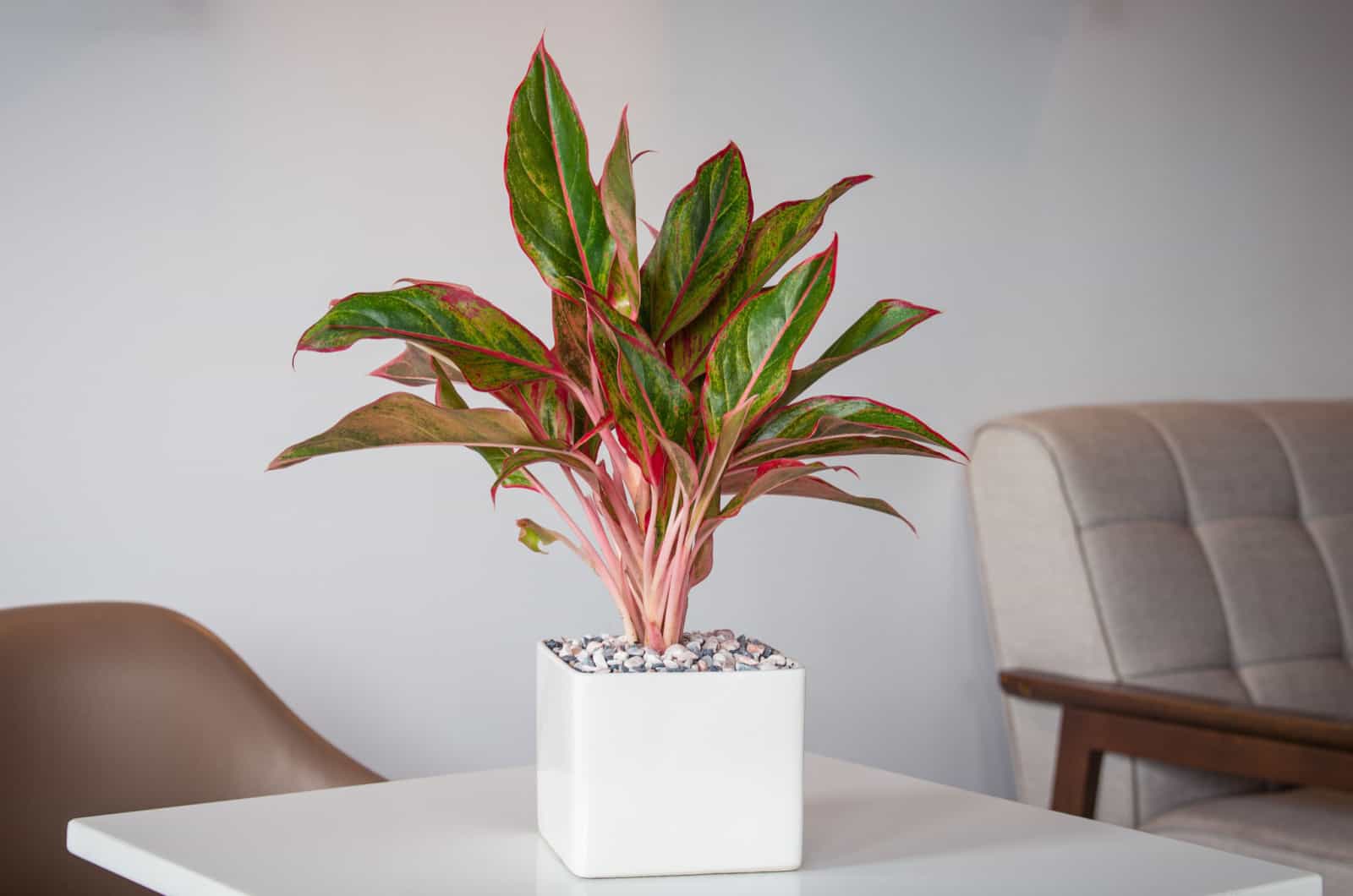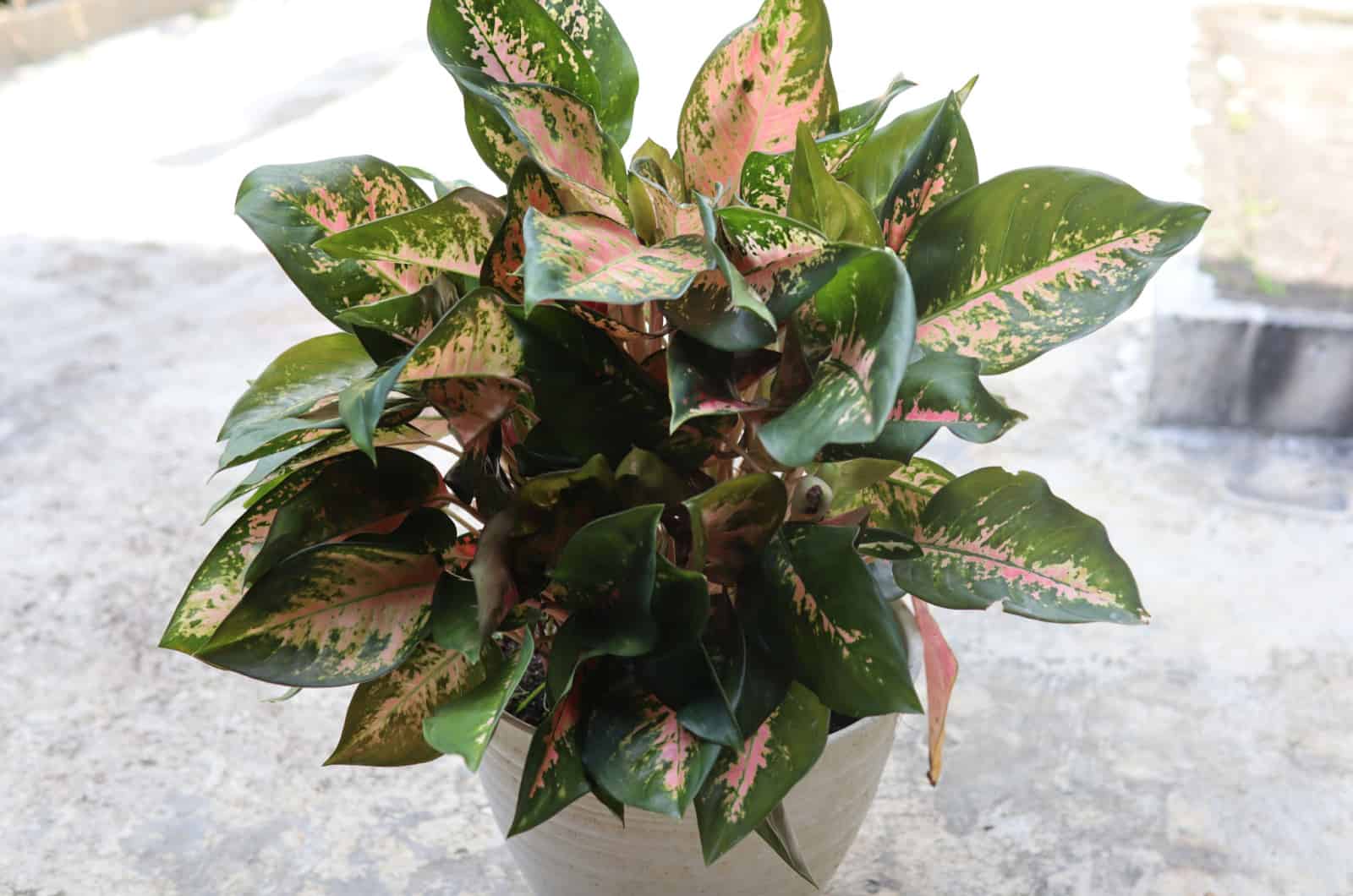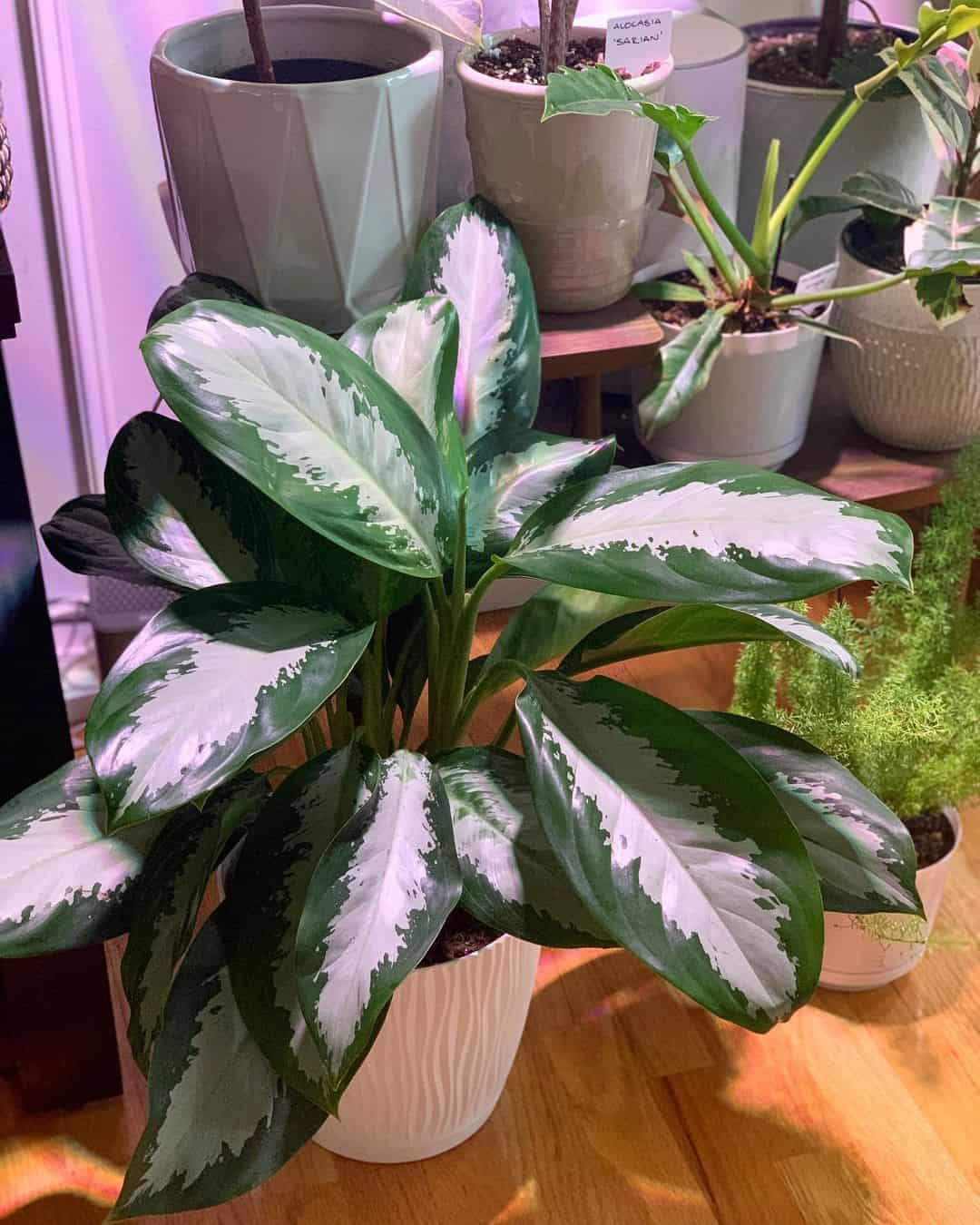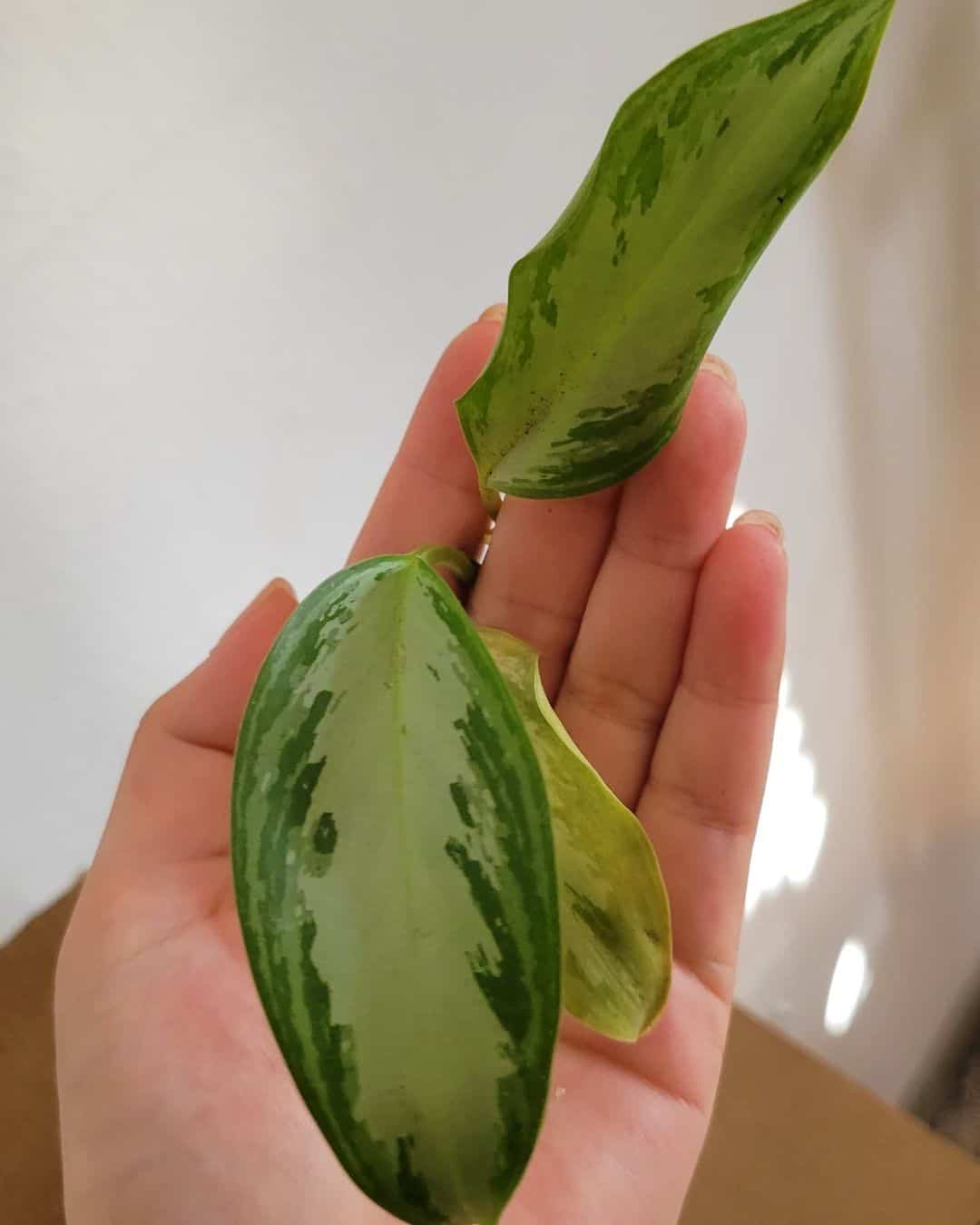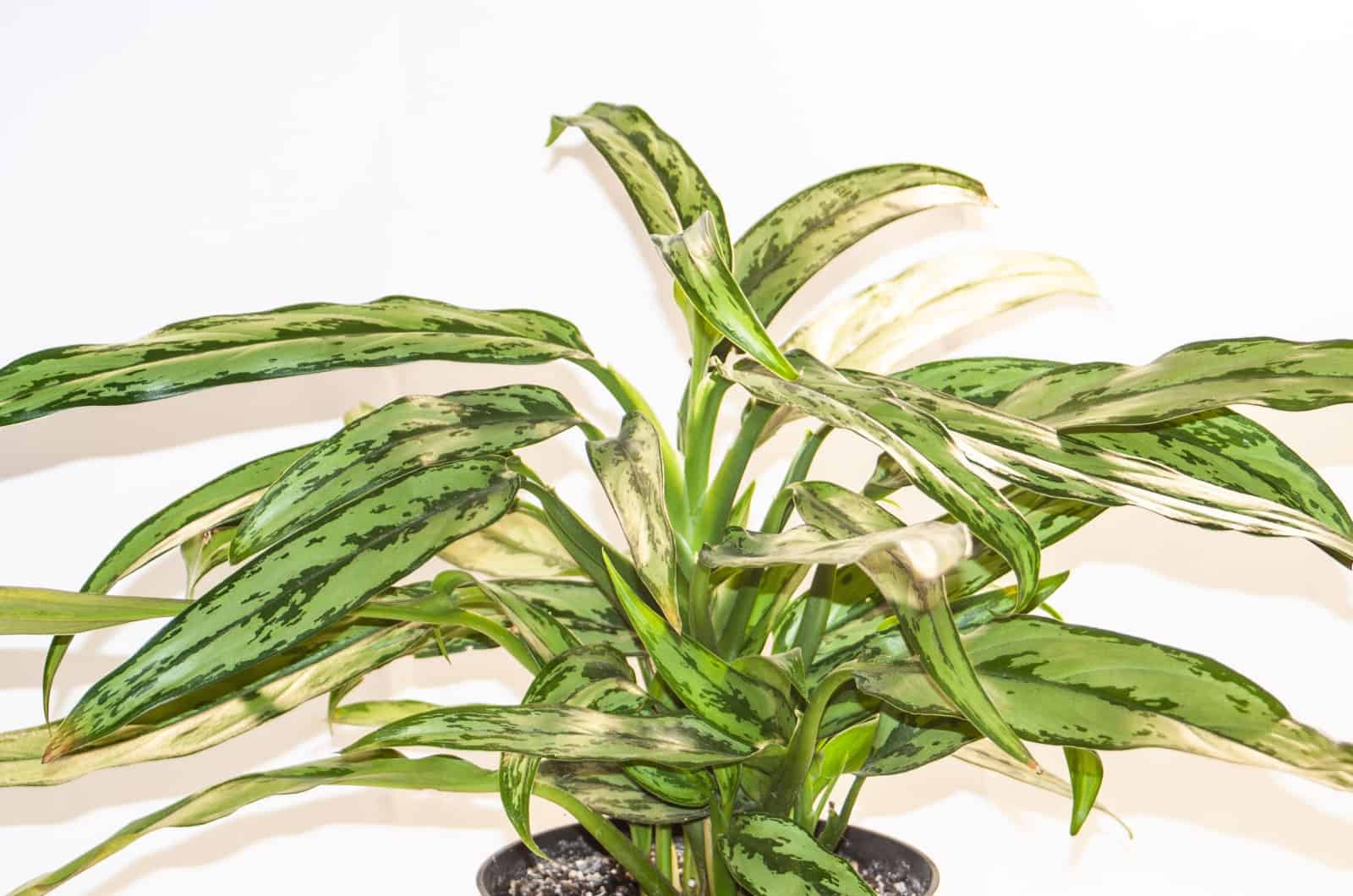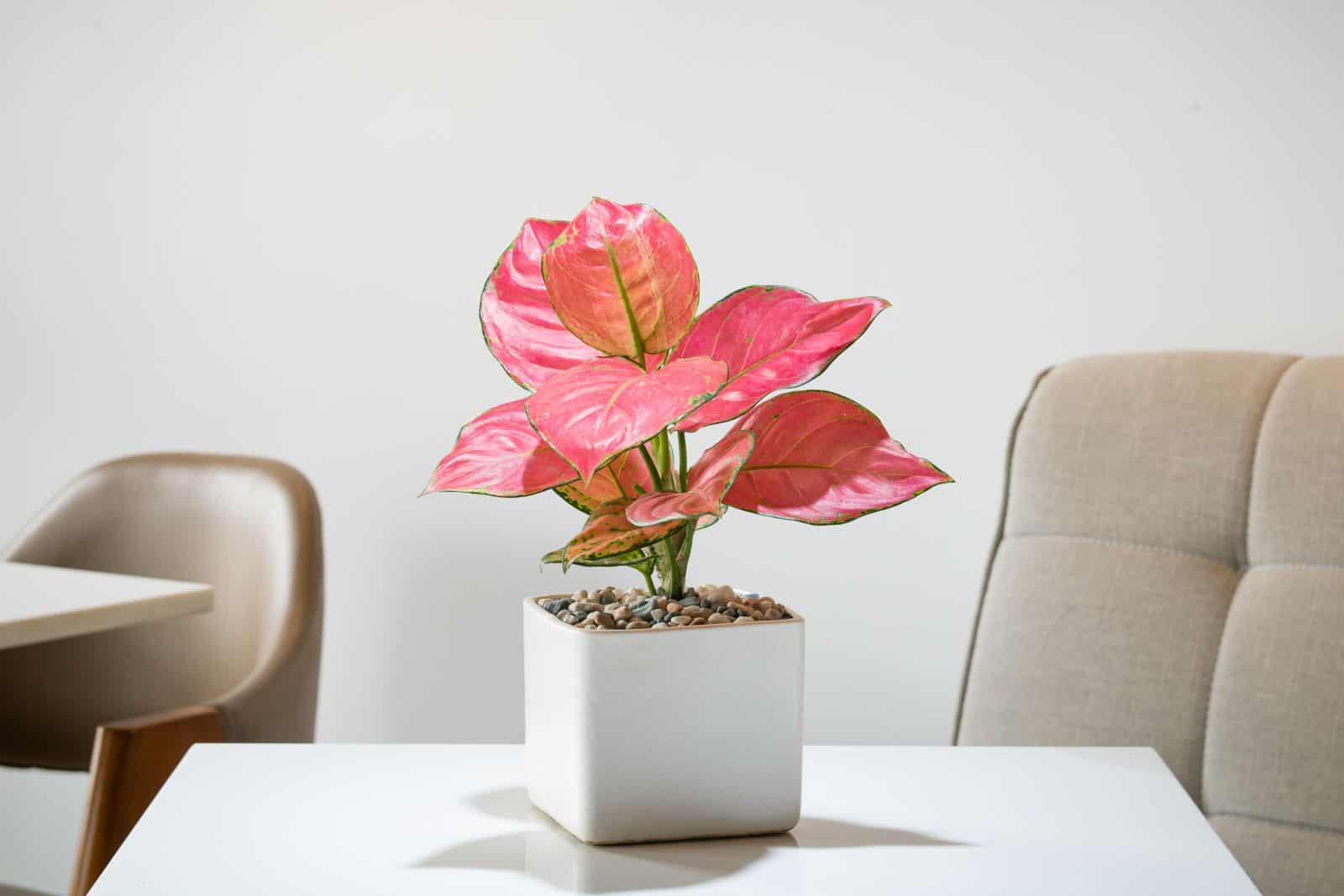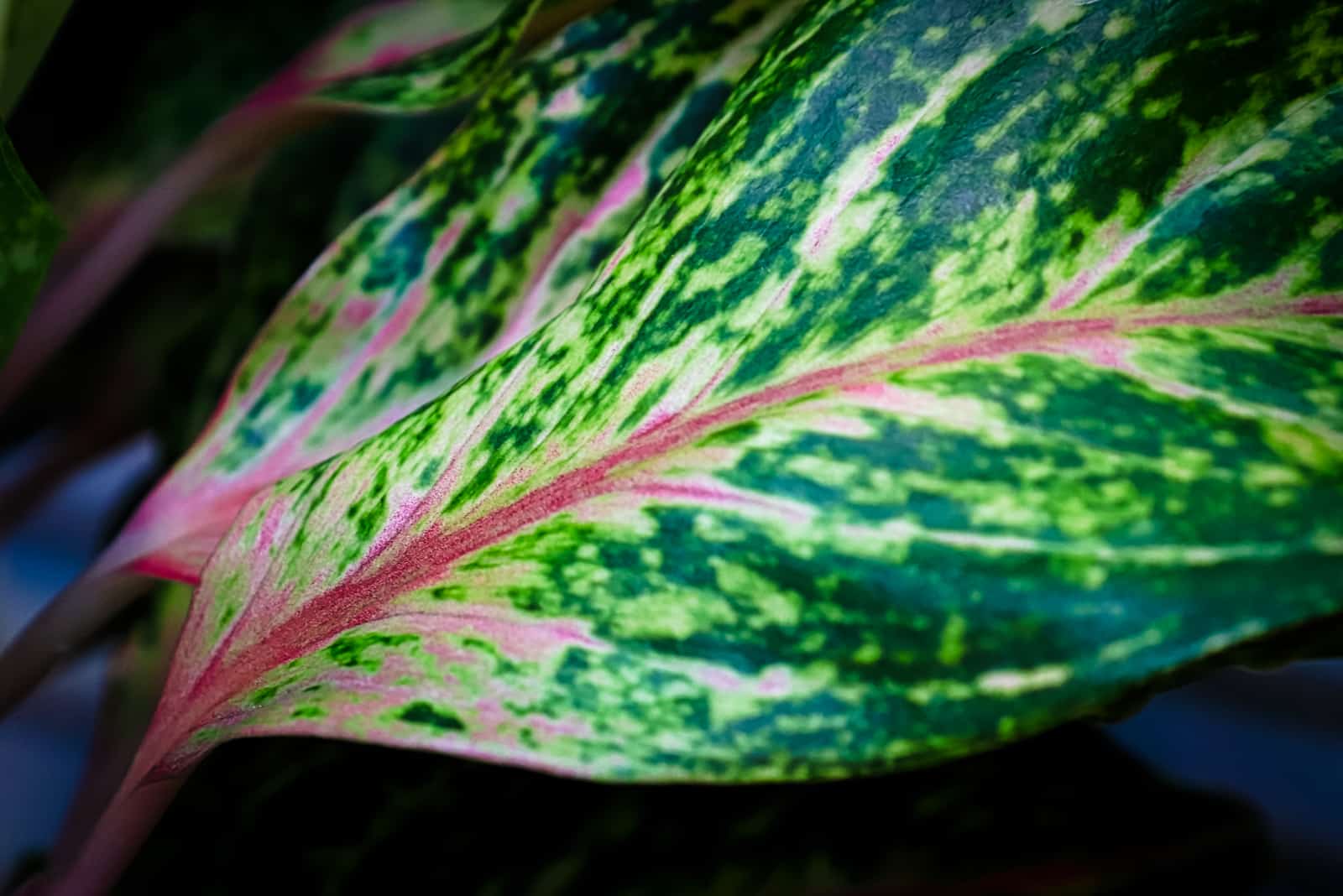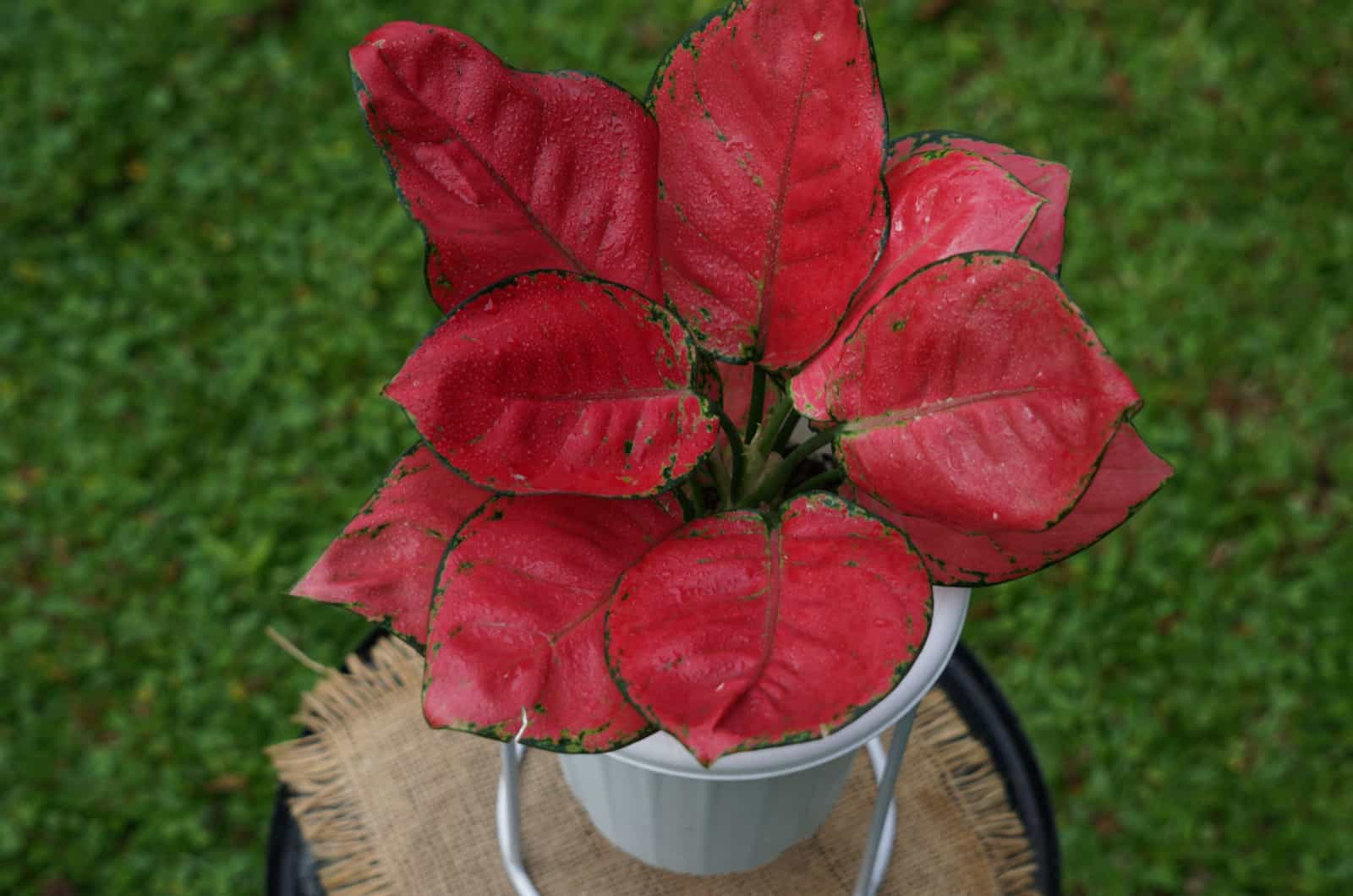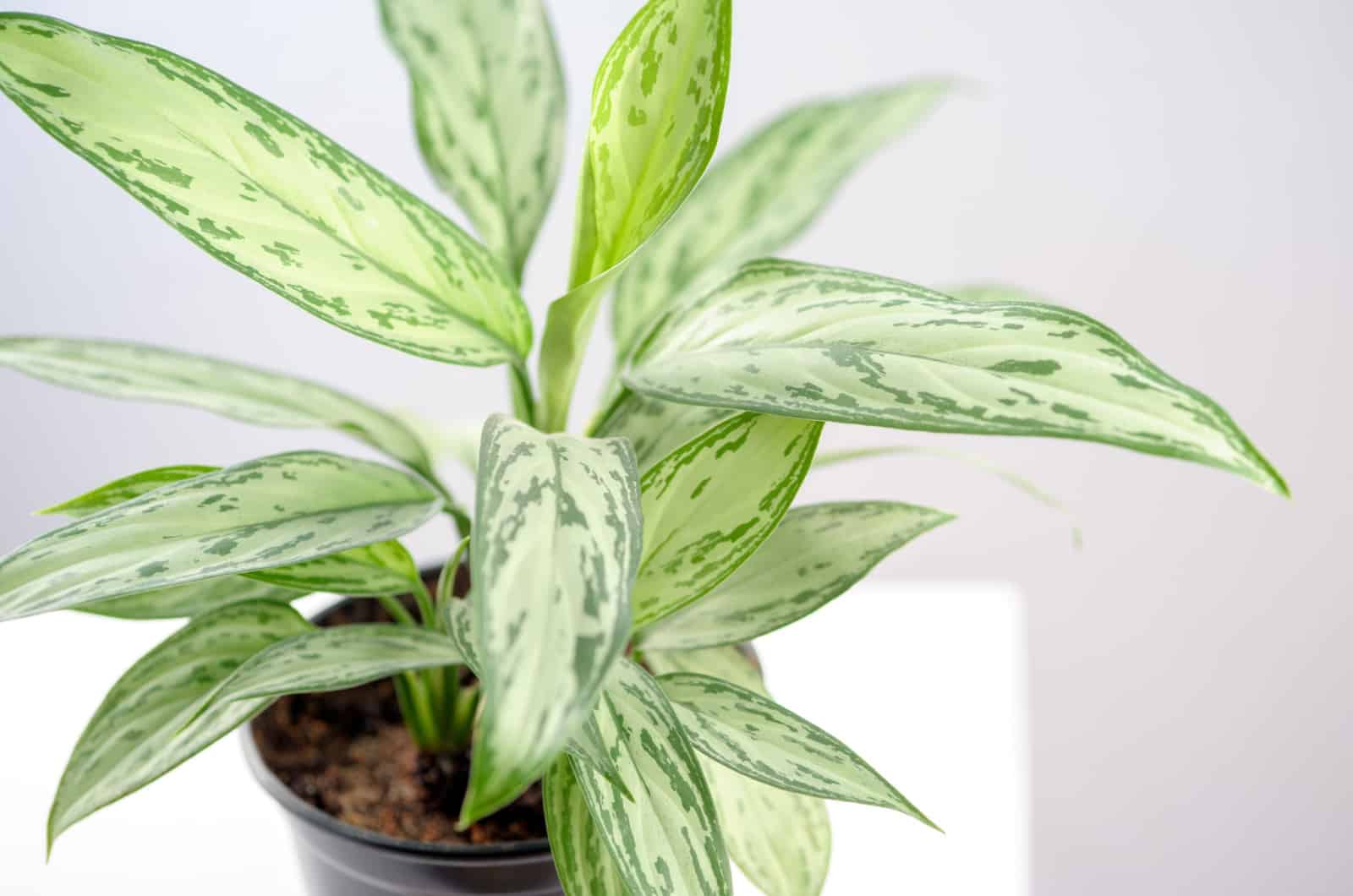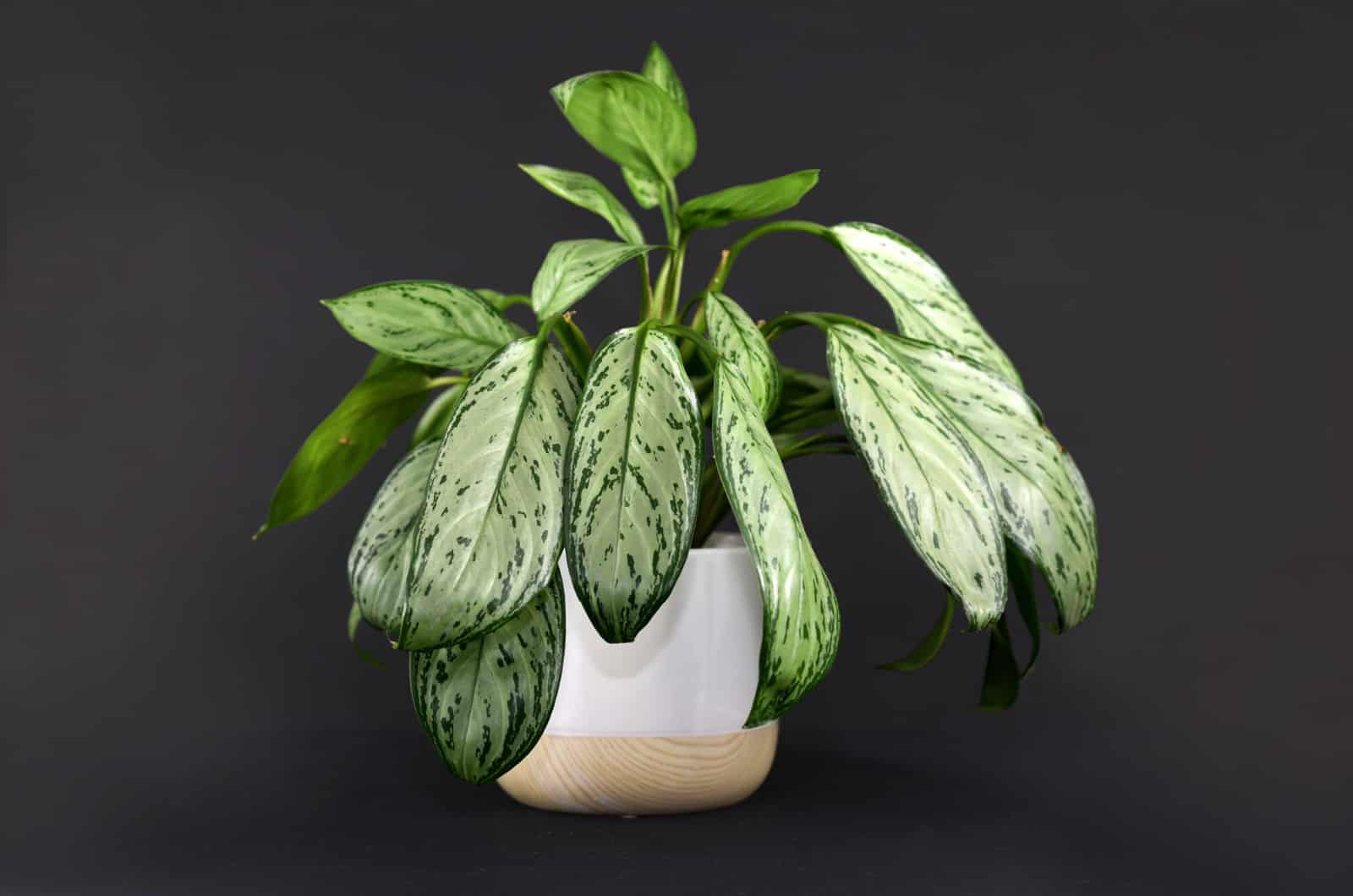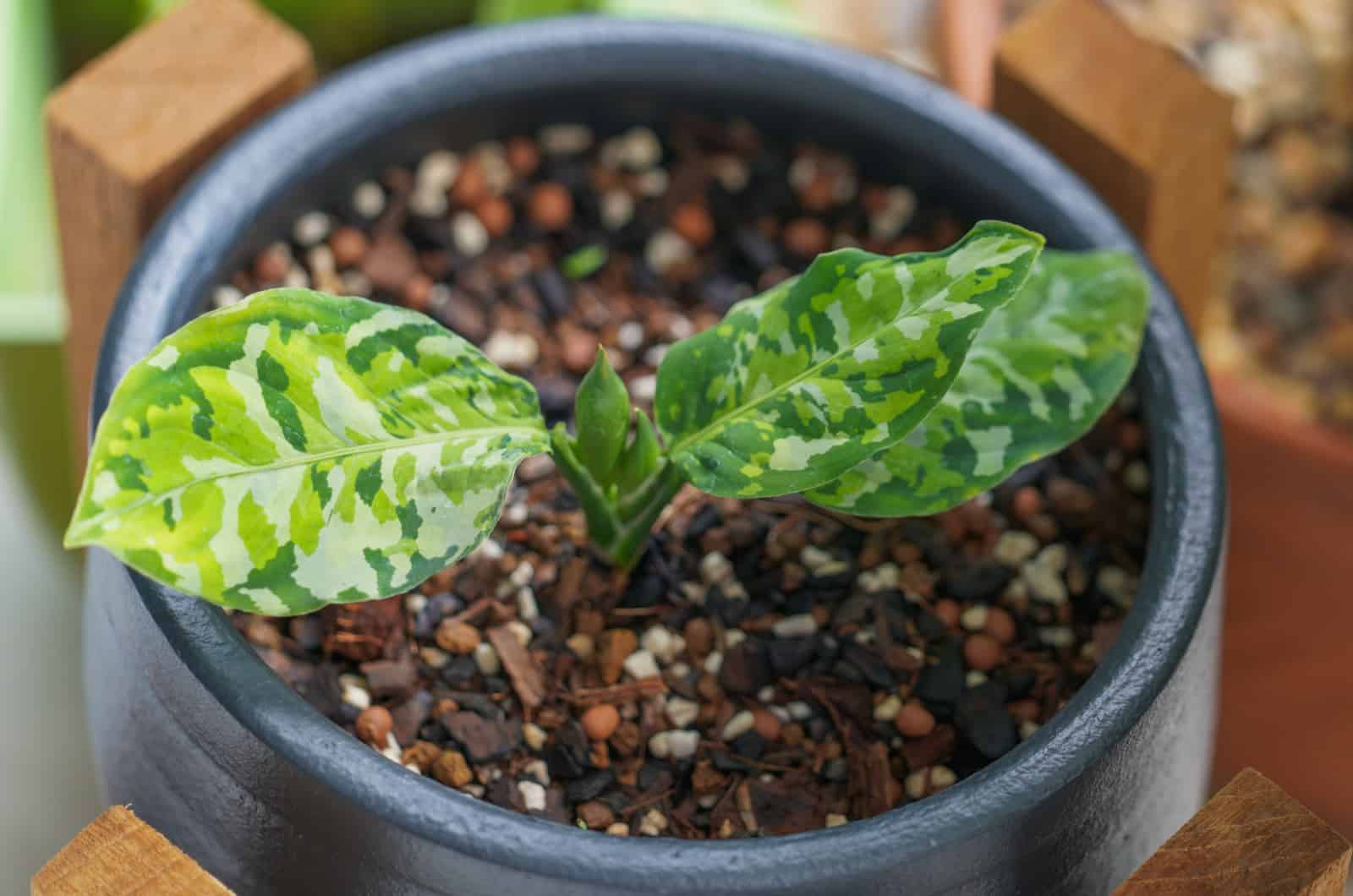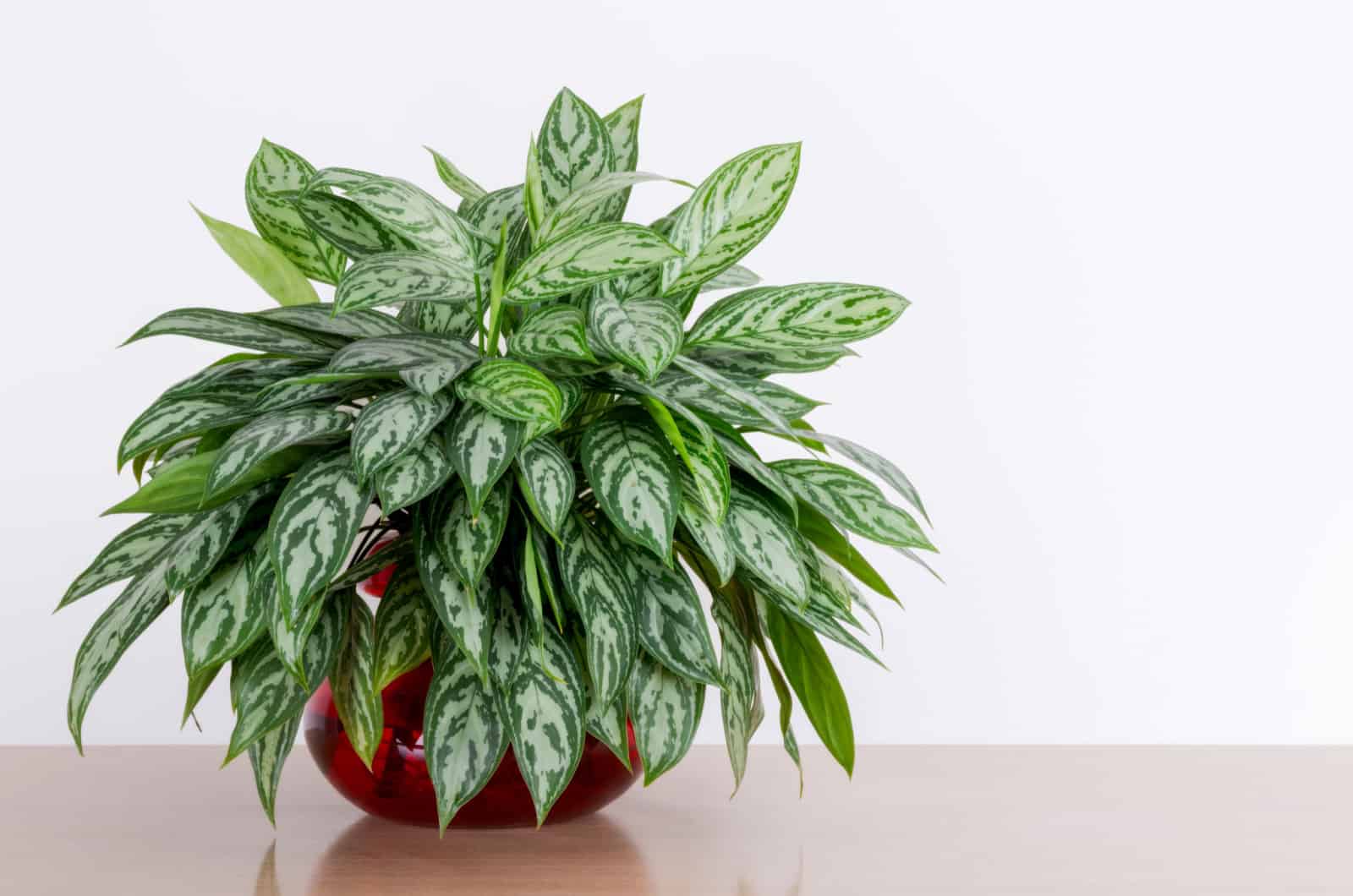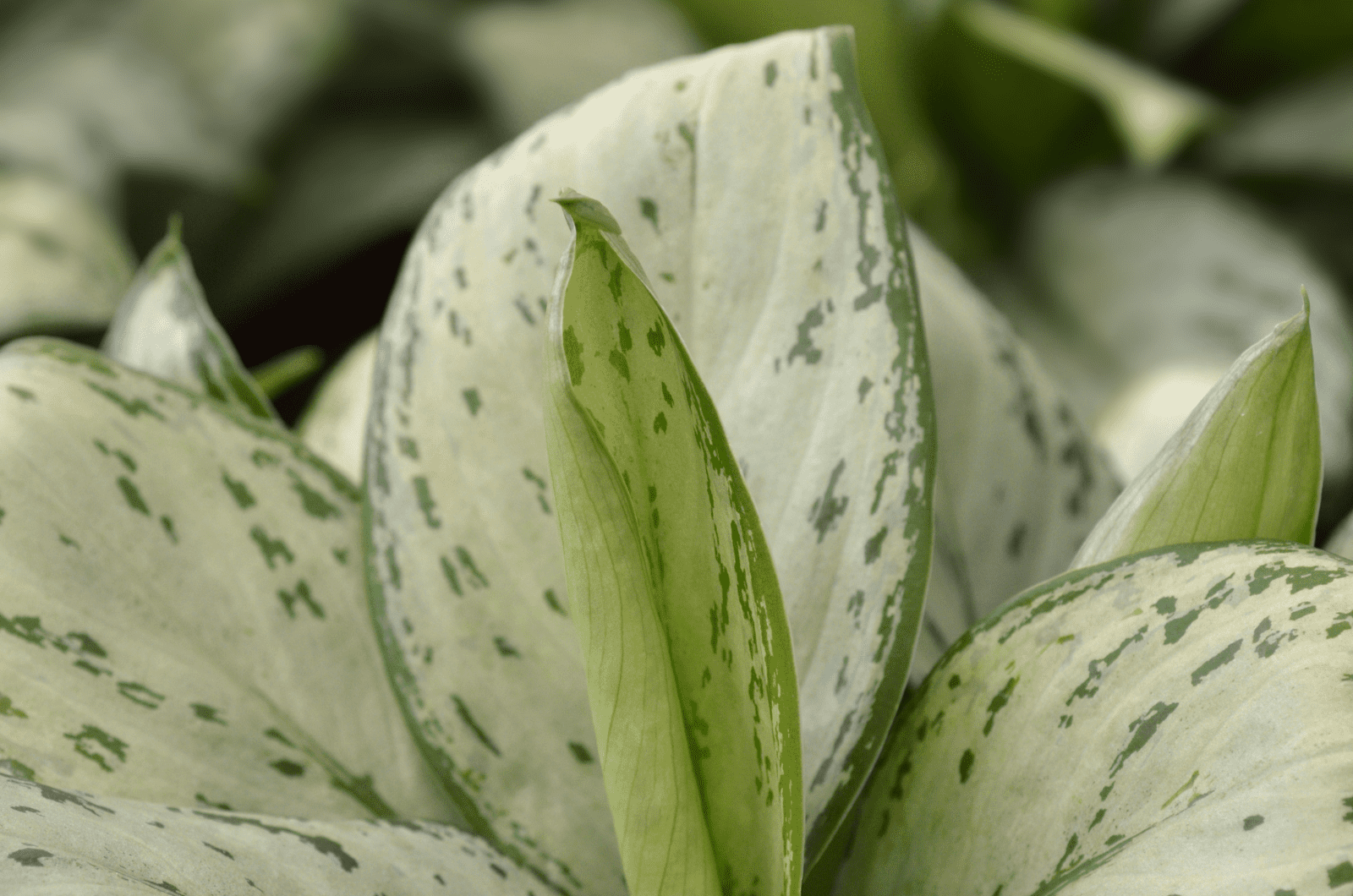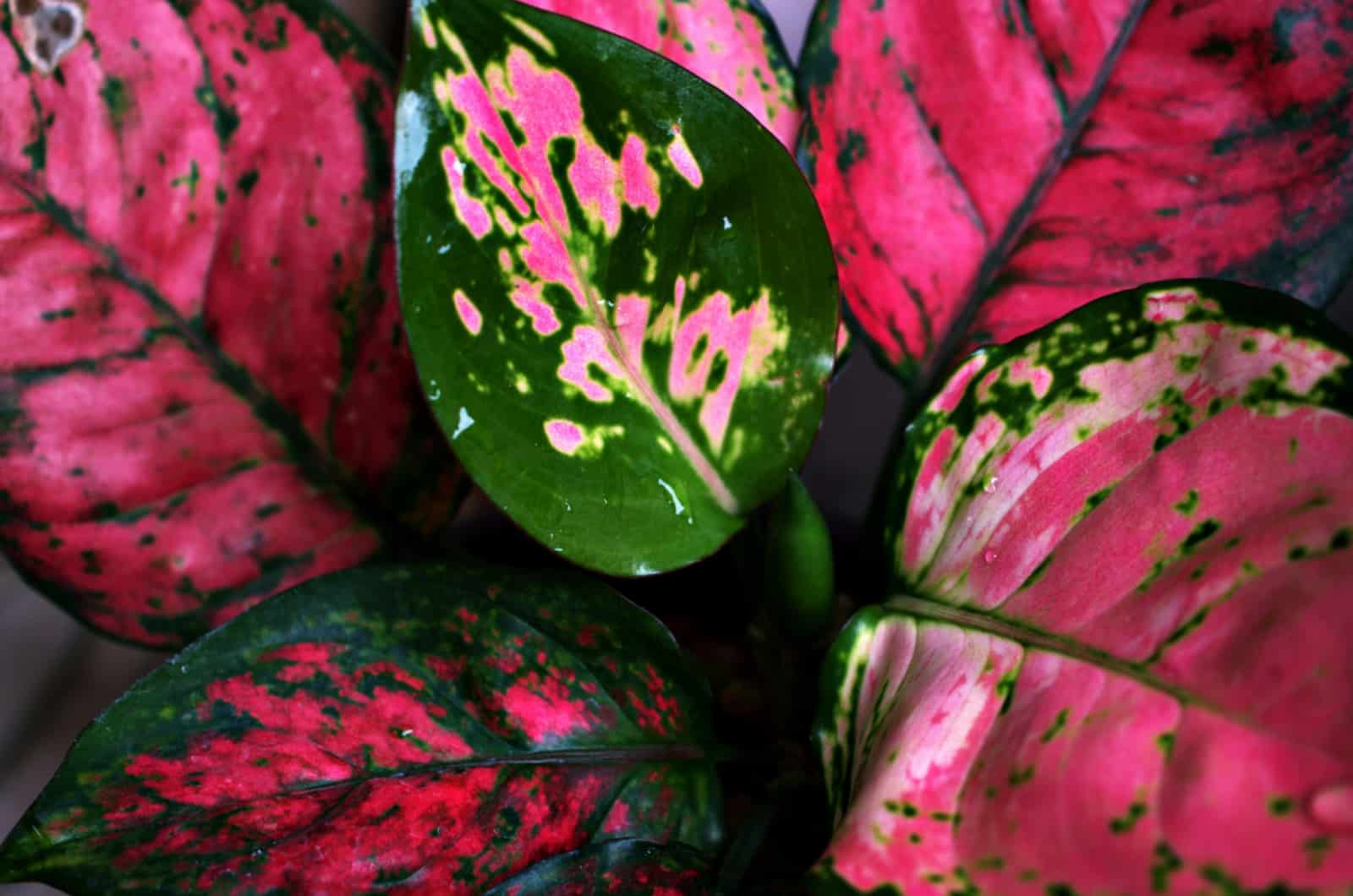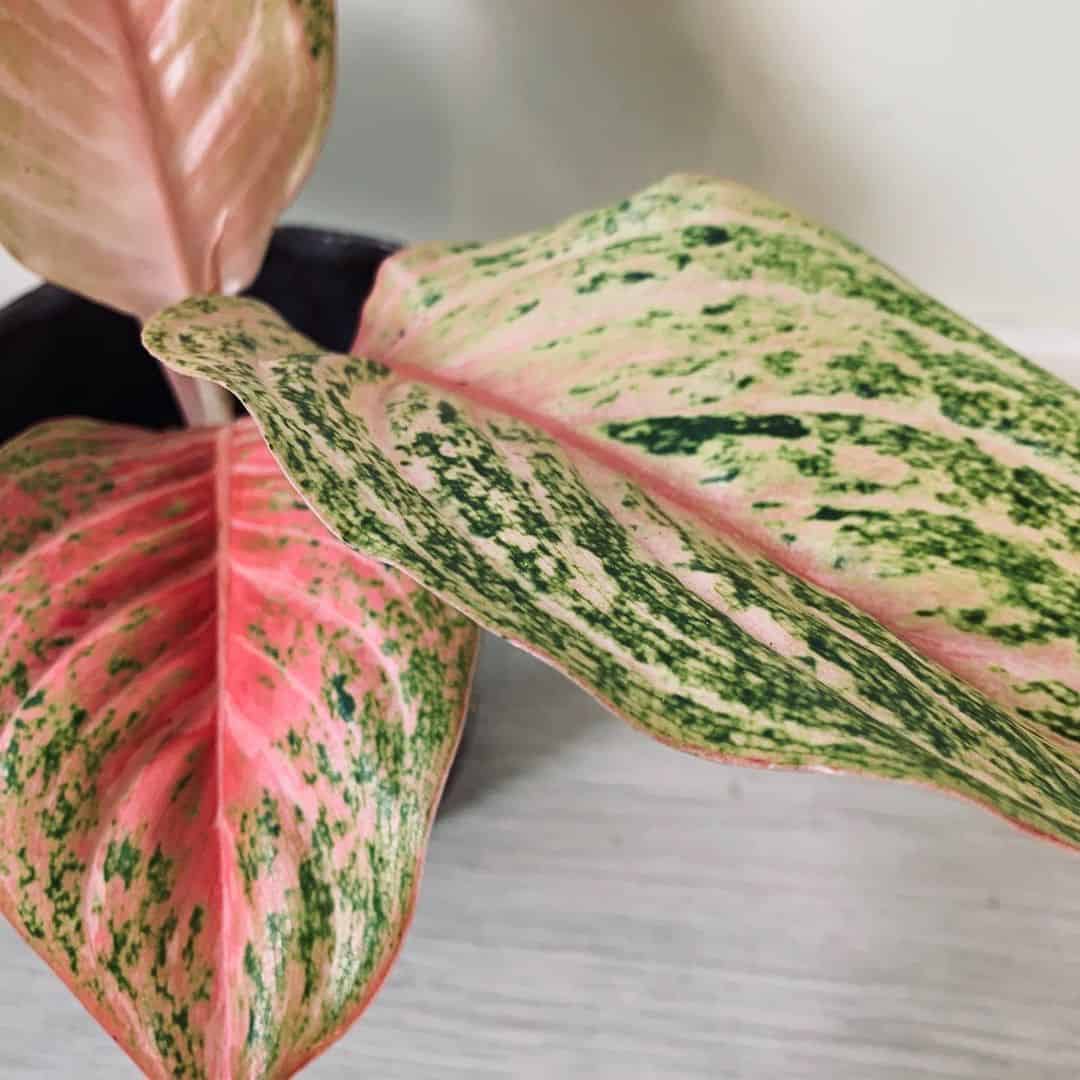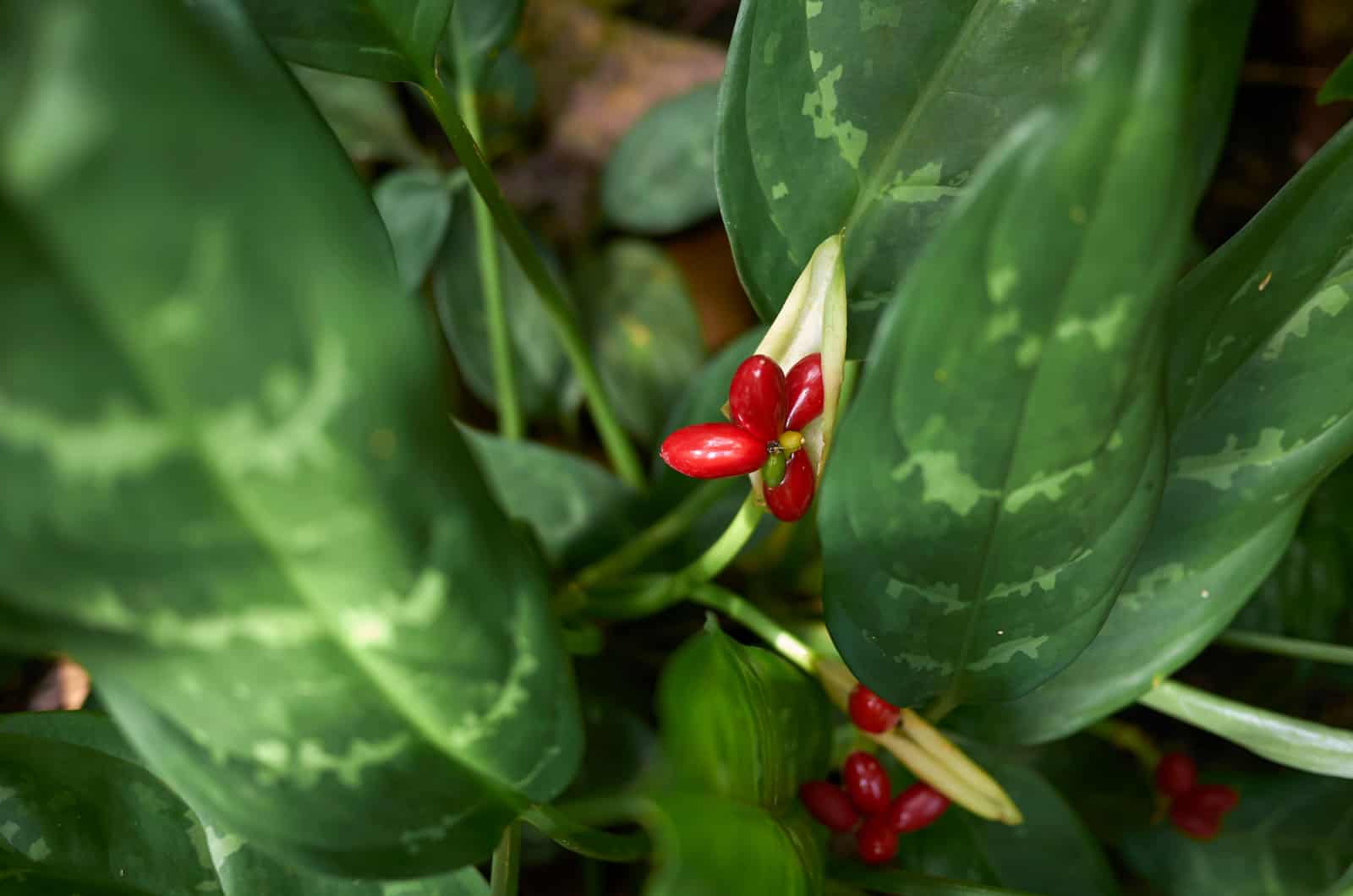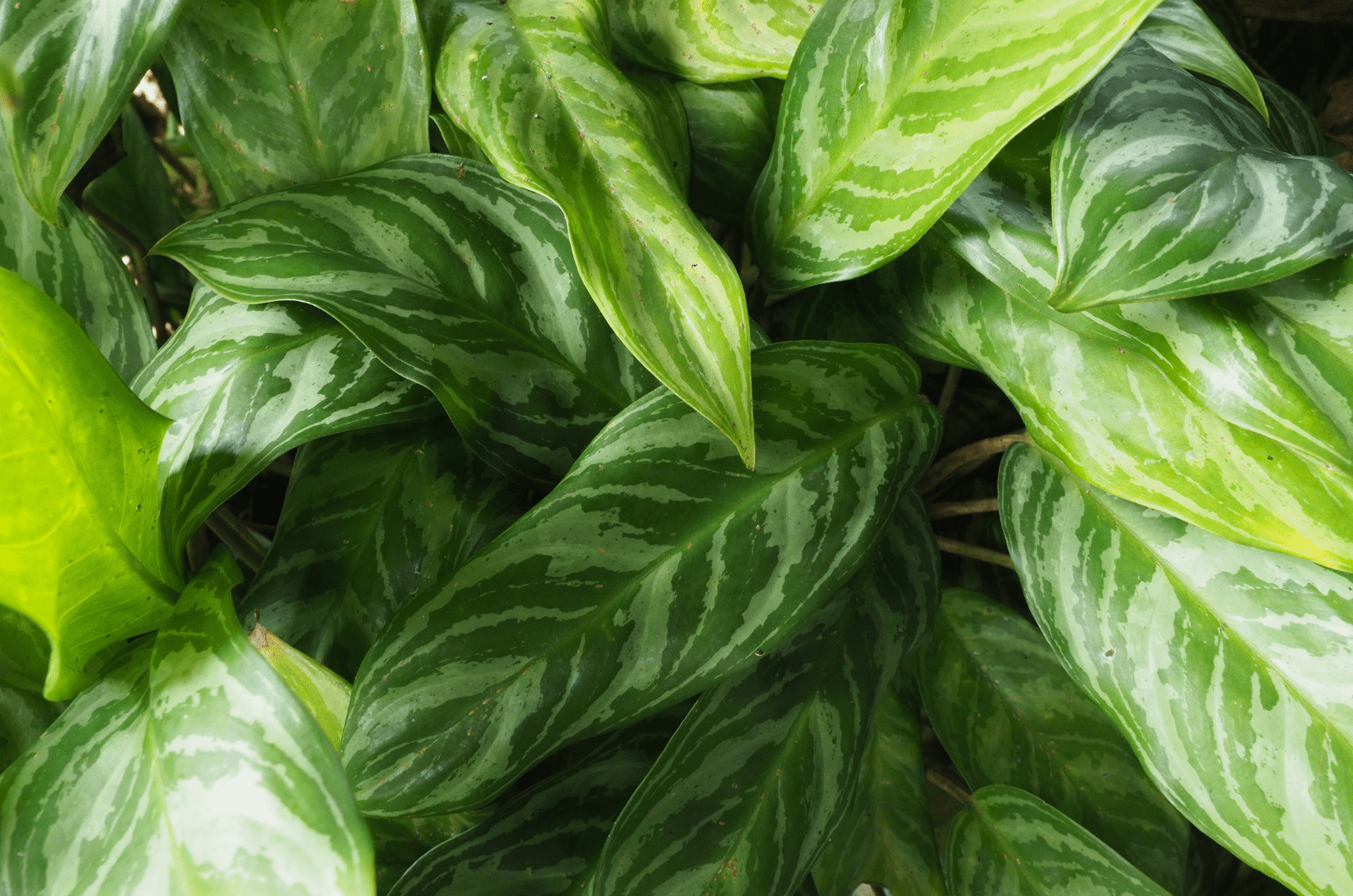There are many species of these wonderful plants, but Aglaonema species identification isn’t too challenging.
This is because certain leaf patterns and colors characterize each species, and some differ due to their size or growth habit.
So, it’s time to find out the most common and the most beautiful Chinese evergreen species to grow indoors!
Before we move on, here is some basic info about these plants:
| Family: | Araceae |
| Genus: | Aglaonema, Schott |
| Common names: | Chinese evergreen, Philippine evergreen |
| Native habitat: | Asia, New Guinea |
| Type: | Herbaceous, perennial |
| USDA hardiness zones: | 10-12 |
| Toxicity: | Toxic to cats and dogs |
Let’s get started!
Aglaonema Species Identification
The most common species from this genus are modestum, siam aurora, pictum tricolor, pink dalmatian, red Valentine, and silver queen.
Here’s how to differentiate Aglaonemas!
Aglaonema Modestum
A.modestum is one of the most common Aglaonema plants grown indoors. The plant became popular due to its magnificent glossy green leaves with a waxy texture.
You can find this variety in two forms, variegated and non-variegated. Variegated modestum plants have white splashes that perfectly combine with their dark green color.
On the other hand, the non-variegated version has all-green leaves, but that doesn’t make it any less beautiful. It’s often referred to as the Green-for-ten-thousand-years plant.
It must be mentioned that these species are very rare Aglaonemas that come in non-variegated versions.
This species is a great choice if you live in hardiness zones 10-11. I grow my modestum plant as a ground cover, and I can tell you that no plant compares to this one when it comes to ground cover.
The leaves are massive and contribute to the overall beauty of the species.
Pay attention to humidity levels and light conditions as this species thrives in high humidity and despises direct sunlight.
Aglaonema Siam Aurora
Aglaonema siam aurora is a plant with red leaves that will leave you speechless! The pointy leaves of siam aurora have green centers and red edges.
Some varieties have glossy leaves exquisitely patterned in a crimson red or light coral color. The first thing you’ll notice when you spot this Aglaonema variety is red variegation on the midribs.
However, sometimes the leaves may be entirely red, which makes this plant easily recognizable.
This species loves bright light, but don’t worry if it grows in a shady spot as the chances of losing variegations are pretty low.
Don’t worry if your area doesn’t get rainfall frequently as the siam aurora is drought-tolerant.
This variety can reach 3 feet, and due to its bushy growth it makes a great addition to any room. Feel free to place it in a bathroom or kitchen as it loves humidity.
Aglaonema Pink Dalmatian
The pink Dalmatian plant is probably the most cheerful. It looks incredible and will be happy even with a bit of neglect.
The leaves are dark green and they have pink splashes. For me, it looks like someone took pink sprinkles and threw them on the leaves. Its pink patches have earned it the nickname, “pink Dalmatian”, and it is just as adorable as the well-known dog of the same name.
The short stems carry beautiful lanceolate leaves. The captivating contrast of colors put it among the most desirable Aglaonema species worldwide.
This species will perfectly fit in any indoor area because it doesn’t require much bright light, making it the best houseplant ever!
It has to be noted that this is a rare species, so if you happen to get one please take good care of it by ensuring a lot of water (but not soggy soil) and high humidity.
Aglaonema Diamond Bay
Photo from: @plantasyfarms
If you aren’t into colorful foliage, but want a simple yet elegant plant, then the diamond bay is the perfect plant for you!
The slender, pointy leaves of this plant have dark-green margins and an almost silvery center. Despite being a relatively new species, the diamond bay is highly prized for its low-maintenance and gorgeous, lush leaves.
You can place it anywhere in your home. It reaches about 30 inches, which makes it perfect for smaller rooms.
This slow-grower prefers moist soil and high humidity. If the humidity is too low the leaves won’t unfold on time and the plant will display stunted growth.
Aglaonema Emerald Bay
Photo from: @justanotherplanthoe
The Emerald bay is very similar to the diamond and silver bay, but the silver color isn’t as noticeable.
This species stands out because of how easy it is to keep the leaves variegated. As you may know, the best way to keep variegations is by giving the plant a lot of bright light.
The Emerald bay will reward you with variegations even if you place it somewhere the light level is pretty low.
So, if you want to add glamor to your office or small apartment, this species is just what you need!
Aglaonema Cutlass
The Cutlass species will draw attention wherever it is displayed because of its striking appearance.
Its elongated, slender lobed leaves, which are almost dagger-like in appearance, are whitish silver and have intriguing dark green markings on them.
This species looks compact as the stems are formed in clusters, it is also a slow grower and will look amazing on bookshelf or desks because it grows up to 19 inches.
It grows well at room temperature, but temperature fluctuations can cause many issues.
It also requires moderate watering, and if you feed it monthly during the growing season it will reward you with its breathtaking appearance.
Aglaonema Rotundum
If you are looking for a fascinating foliage plant to add to your plant collection or to give as a gift, then the rotundum species is just what you need.
These slow-growers feature massive, slender, oval-shaped leaves that grow from short stems.
This species isn’t something you’ll often see cultivated indoors, but it’s one of the best Aglaonemas because the dark green leaves perfectly combine with white veins on mature plants.
The leaf patterns aren’t noticeable on younger plants, so you should pay attention to every aspect of plant care if you want to see them.
I mentioned earlier that the lighter variegated foliage needs plenty of light to preserve this feature, so it’s logical that this species doesn’t require a lot of bright light.
Therefore, if you want to add a plant to a room with low light conditions, the rotundum species is a perfect choice.
Aglaonema Sparkling Sarah
One of my favorite cultivars is the Aglaonema sparkling Sarah. Due to the breathtaking pink veins that form on dark and light green leaves, it has become a common houseplant for interior design.
Compared to other species from this genus, this plant is slightly larger. It can reach 48 inches tall, whereas the pointy, elongated leaves may reach 8 inches.
It’s easy to differentiate a sparkling Sarah from other species due to the pink color of the stems.
If you ensure warmer temperatures, bright indirect light, and well-draining soil, this tropical plant will truly sparkle!
Aglaonema Red Anjamani
If you want to spice up your space, but you aren’t into spending a fortune on eccentric art, what other options are there?
Get yourself an Aglaonema red anjamani and watch it transform the mood of your room, especially if you use it as a countertop decoration in a small container.
With its amazing, brilliantly red leaves and a few dark green splashes and edges, this houseplant is gorgeous in every way. This species is really awesome because, unlike the similarly magnificent poinsettias, it keeps its brilliant color all year round.
I recommend placing this plant in a silver pot to highlight its stunning red coloring, and you’ll also be able to see how its remarkable appearance radically changes the atmosphere of your area.
Aglaonema Silver Queen
As you may assume, this species features variegated silver foliage. Due to its appearance, this plant really deserves the name silver queen – it looks so royal and elegant!
The leaves of the silver queen are lobed and rich in silver variegations. This species doesn’t grow very tall; you can expect it to reach 24 inches in its mature growth stage.
Of course, plants often reach their mature size when every requirement is met.
For this species, the conditions you need to ensure are well-draining soil, a lot of bright light, warm temperatures, and high humidity.
Silver Bay Aglaonema
The oval-shaped, long, and pointy leaves of the silver bay make this Chinese evergreen species one of the loveliest!
This bushy species can grow up to 36 inches tall, whereas the leaves may reach 10 inches in length.
The leaves are leathery to touch and have beautiful silvery markings on their dark green surface.
This variety isn’t cold-tolerant, so you should keep temperatures above 55 degrees Fahrenheit to avoid losing the silver markings and drooping.
The great thing is that this species make great groundcovers outdoors ( in outdoor spaces in warmer hardiness zones, such as 10 and 11).
Aglaonema Pictum Tricolor
If I had to choose only one species of Aglaonema to grow indoors, it would definitely be pictum tricolor!
As the name implies, the leaves feature three colors: lime green, the ‘regular’ green, and pine green.
The egg-shaped leaves remind me of camouflage, but don’t worry – it’ll be pretty noticeable in your room!
This Chinese evergreen may reach 2 feet tall.
One tricky thing with this species is the light level. If you want to preserve the spectacular leaf color, you’ll need to ensure a lot of bright indirect light.
This species is also drought-tolerant, so avoid waterlogging the soil as the plant is prone to root rot.
Aglaonema Maria
I want to tell you more about the Aglaonema Maria species. It features long, orbicular leaves that cluster into dense clumps, so it will bring a tropical vibe to wherever you place it.
The dense, dark-green foliage has a few distinctive patterns that are light-green or cream-colored. You can group several of these plants for lush interior foliage plants or combine them with the vibrant Aglaonema species to create the impression of a little tropical jungle.
It will be easy to preserve variegations on the leaves as they aren’t as noticeable and colorful as other species.
Aglaonema Maria Christina
The Aglaonema Maria Christina is an ornamental plant that resembles the silver queen Aglaonema due to its whitish-green centers.
However, it isn’t hard to differentiate the Maria Christina due to the dark green edges. Additionally, this species has green blotches that look like thicker veins.
What’s interesting about the Maria Christina species is that they’re cold-tolerant, unlike other Aglaonemas that prefer warmer temperatures.
If you want more Maria Christina plants, you can choose between two propagation methods: stem cuttings and division.
Aglaonema Red Valentine (Chinese Evergreen Lady)
It won’t be easy to find a plant as colorful and lively as the red Valentine, also known as the Chinese evergreen lady.
Its unusually large, egg-shaped leaves have dark green edges with abundant hot-pink splotches and red centers, giving the plant a stunning appearance. The hue of the leaves typically begins as pink, and it develops into red as the plant reaches maturity.
I’m sure you’ll agree that the Chinese evergreen lady deserves to be a part of every plant collection.
This is a long-living species when it’s provided with all the conditions it requires.
Consider gifting it to your loved ones, I’m sure they’d be thrilled.
Aglaonema Bidadari
Photo from: @veras_plants
The Chinese evergreen variety, bidadari, is easily identified, especially when grown as an indoor plant. This lovely plant features massive, glossy, oblong leaves with bright pink, green, and beige splashes.
The narrow pink stems support the leaves above them and develop in clusters, which give the bidadari plant a lush appearance.
The first thing you’ll notice when looking at a bidadari is the shade of pink on the leaves. It seems as if each leaf is individually designed – a true work of art by Mother nature.
This species isn’t demanding at all, so if you are a forgetful person or you don’t want to spend too much time fulfilling the plant’s wishes, you should get a bidadari plant.
Aglaonema White Rain
If you are looking for a more subtle and classy Chinese evergreen plant, the white rain species is just what you need!
The elegant foliage comes in two colors, green and creamy. This plant was chosen for the list because it exemplifies how Aglaonema plants can be both tranquil and also kind of arrogant in their appearance.
Most other Aglaonema species feature leaves that seem to bend downwards over the pot, but the white rain stays upright. The plant has pretty, thin leaf tips that give the plant an exquisite appearance.
Aglaonema B.J. Freeman
At first sight, the modest BJ Freeman plant doesn’t differ from other typically green plants at all. Still, if you look closer, you’ll find that the wide, light-green foliage has dark-green dots along the midrib and margins.
The BJ Freeman is an incredibly simple indoor plant that can thrive in various light conditions. The watering requirements are also low, though you should be careful not to overwater it.
This is a relatively new species, and is often described as a dieffenbachia plant due to its size. It can reach 60 inches tall, which is above the average height of Aglaonema plants.
This plant is suitable for beginners, especially those who prefer simplicity and standard green foliage plants.
Aglaonema Nitidum
Nitidum species are often called Painted drop tongues and make excellent indoor plants. If you live in a warmer climate, you can also grow this species outdoors as borders or ground covers.
These plants produce green or creamy white blossoms that resemble those of the calla lily.
The nitidum species are commonly seen in shopping malls as they are pretty easy to maintain; they tolerate different light levels and don’t need frequent waterings.
When these plants get everything they need (and that’s not a lot), they have a long lifespan.
Aglaonema Commutatum
I would like to end the list with the most common species of the Aglaonema genus. The commutatum plant is the standard variety and is often confused with the dumb cane plant from the Dieffenbachia genus.
It features elongated, standard-green leaves with silverish centers. The plant is also known for its white flowers and crimson berries, but, unfortunately, you will rarely see flowers and berries when this plant is grown indoors.
Aglaonema Plants: Features And Care Guide
This is a large genus with over 20 species and 120 varieties.
So, the question is, what makes these plants so special that they are grown and appreciated worldwide?
First of all, Aglaonema plants are air purifiers according to NASA research. That means that if you grow these plants indoors, the concentration of harmful formaldehyde and benzene decreases.
Due to the size of the leaves of all species, these plants emit high oxygen levels.
For those who are more into symbolism and Feng Shui, Chinese evergreens are considered to be lucky plants. They are said to bring wealth to households.
These plants are also long-lasting, so keep reading to find out how to keep them healthy and thriving for a long time.
There’s one drawback when it comes to these plants – they are toxic to humans and pets, so be careful where you place them so that dogs, cats, and small children can’t reach them.
We’ll now discuss the conditions you need to ensure if you decide to grow these plants. We’ve seen that some varieties can tolerate lower light conditions better than others, but all plants from this genus have certain things in common when it comes to plant care.
Let’s learn more!
Care Guide
The requirements of these plants when grown indoors are simple, and Chinese evergreens will grow well even if neglected a little bit.
Light Conditions
Most Chinese evergreen plants are variegated, and the lighter the variegation, the more light the species needs.
Generally speaking, these plants will do best in bright indirect light, though some species will thrive even in low light conditions.
But all plants from this genus have one thing in common – they are extremely sensitive to direct sunlight!
Therefore, they’ll adapt well to all light conditions as long as the direct sun doesn’t reach the leaves.
Temperature Conditions
These plants prefer warmer temperatures and are hardy only in USDA hardiness zones 10 and 11.
As long as the temperatures indoors exceed 65 degrees Fahrenheit, these plants will grow just fine.
One thing is almost as dangerous as cold – temperature fluctuations and cold drafts. So, make sure to keep these species away from heaters, vents, air conditioners, and drafty windows.
Humidity Conditions
Another thing that these plants can’t tolerate is low humidity. You’ll need to increase it if you want your Aglaonemas to grow well.
There are various methods that may aid you in this. First, you can use a humidifier, which is the safest way to monitor and maintain the necessary humidity levels.
Another method is placing these species near other indoor plants, such as Philodendrons or succulents.
You can also keep humidity higher by misting your plants regularly.
Soil
Chinese evergreen plants aren’t fussy about the soil type. Purchase a well-draining and slightly acidic potting soil to avoid overwatering, and your plants will also have enough nutrients.
If you notice any issues with drainage, mix perlite or pumice into the soil.
A pot with drainage holes will help you avoid overwatering.
Watering Schedule
The key to an appropriate watering schedule is keeping the soil moist, so don’t let the excess water stay in the soil, but don’t let it dry entirely either.
Water more during warmer periods, and less during the colder months.
Fertilizer
I know you want to keep your plants healthy and boost their growth a little bit, but remember that they aren’t heavy feeders.
I recommend fertilizing them once the growing season starts and again when it ends. Use a liquid, all-purpose fertilizer.
Repotting
When repotting, pay attention to the soil type and pot size.
Always use fresh soil and make sure the pot is a little bit bigger than the previous one. Repot if your plant is rootbound and you see the roots are coming out of the drainage holes.
Here is a video on how to repot Aglaonema plants:
Common Issues
These plants aren’t prone to pests and diseases, and the most common issue that affects them is leaf curl.
It may be pretty tricky to figure out what’s causing the curling. Check the light level, humidity level, and soil moisture content.
If everything is fine, think about the age of the leaves; the older the leaves, the bigger chances of curling.
Make sure not to add water too frequently as these houseplants are sensitive to overwatering and may quickly get root rot.
Wrapping Up
I’m sure you now know which species will be best for you to grow!
This Aglaonema species identification guide will have made your choice easier, and now you know how to tell each species apart as well.
One thing is certain – each species has a unique appearance due to the leaf patterns, shape, texture, and color.
So, what are you waiting for? Go and identify which Chinese evergreen you have, or get yourself one!
Until next time!

